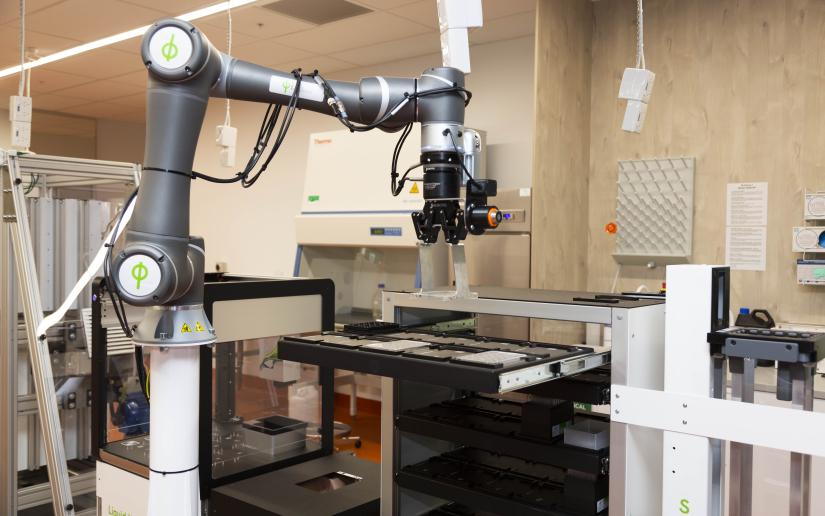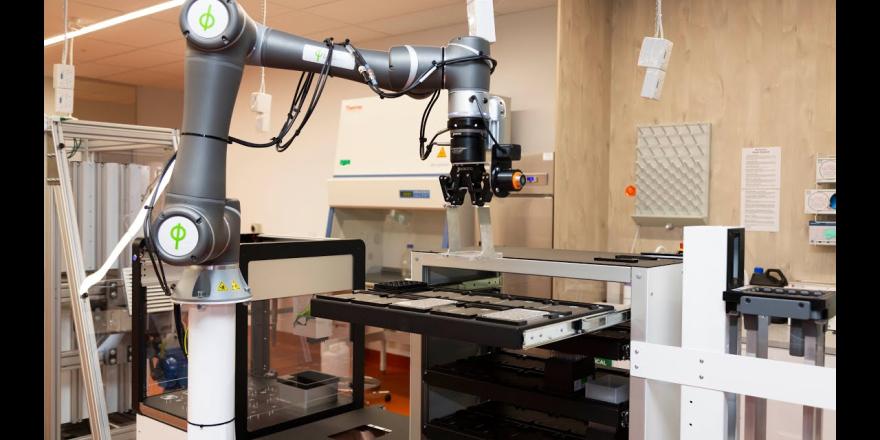World first technology, led by UTS research, will accelerate the discovery of climate change fighting ‘super algae’.

The world first robotic system is the equivalent of 20 scientists working 24/7 on finding ‘super algae’. Photo by Marcus Stimson.
New technology driven by research from The University of Technology Sydney (UTS) will revolutionise the identification of ‘super algae’, which hold the key to helping industry rapidly decarbonise and vastly improve sustainability.
Algae are microscopic aquatic plants that, when grown in a bioreactor, can soak up carbon from the atmosphere up to 40 times more efficiently than trees. With the right traits, these algae can then be used in industries such as food and beverage, textile fibre, bioplastics and biofuel.
Partnering with the world leader in the development and manufacture of high-end instrumentation for research in the biological sciences, PSI (Photon Systems Instruments), UTS researchers in the Climate Change Cluster (C3) have pioneered a world-first fully automated robotic system to screen thousands of types of algae each day, enabling scientists to zero in on the traits necessary to accelerate discovery across a range of industries.
PARTNER WITH US!
UTS Climate Change Cluster
Previously, it took scientists around six months of manual, full-time experimental work to identify the traits of one single strain of algae. This new technology enables that same strain of algae to be analysed in just one week. That’s a cost savings of more than $2 million per year.
Our collaboration with PSI, a global tech leader with a shared mission to support industries to become more sustainable, is a game changer in the pursuit of using ‘super algae’ to combat climate change, and will create a new algal biotech industry here in Australia.
Distinguished Professor Peter Ralph
Director, UTS Climate Change Cluster
Distinguished Professor Peter Ralph, Director of C3, says the robotic system is the equivalent of 20 scientists working 24/7 on finding these ‘super algae’.
“For every algae species we have in culture, there are hundreds of thousands that are yet to be identified. By drastically accelerating the discovery and characterisation of using this advanced tech, we are unlocking enormous potential for industry to quickly utilise ‘super algae’ to decarbonise their manufacturing processes,” said Professor Ralph.
“Our collaboration with PSI, a global tech leader with a shared mission to support industries to become more sustainable, is a game changer in the pursuit of using ‘super algae’ to combat climate change, and will create a new algal biotech industry here in Australia.”
PSI built the first-of-its-kind fully automated robotic system, called the Algae Phenotyping System, informed by C3 research.

A time lapse video of UTS researchers and PSI engineers putting together the world first algae robot technology in a UTS laboratory.
“With rapid advances in fundamental technologies, PSI is translating them into easy to use applications for research centres and industry. For nearly 30 years we have been developing state of the art and one of a kind technologies, often in close collaboration with leading researchers around the world.
“Our technology can be found in over 80% of the world’s highest ranked academic institutions and most recently one of our hand-held devices was used on board the International Space Station (ISS). Automated systems such the one at UTS use robotic applications and computer vision to do repetitive tasks previously undertaken by humans. They will accelerate discovery by allowing scientists to do more of the creative work.
“UTS is leading the way in characterising and better understanding how super algae can play a critical role in decelerating climate change. For this reason, we believe that Australia can be on the forefront of this field, developing new technologies and providing vast benefits to industry. In turn we should see significant revenue increase in end user companies as well as new job creation,” said Martin Trtilek, Founder and CEO of PSI.
The automated “Algae Phenotyping System” is designed to be fully scalable for industrial purposes. Whether in a small university lab or industrial sized warehouse, PSI has the ability to scale the solution with ease.
UTS and PSI will next focus on adapting the system to analyse traits in different strains of seaweed. The seaweed-focussed industry is estimated to be worth US$15 billion.

